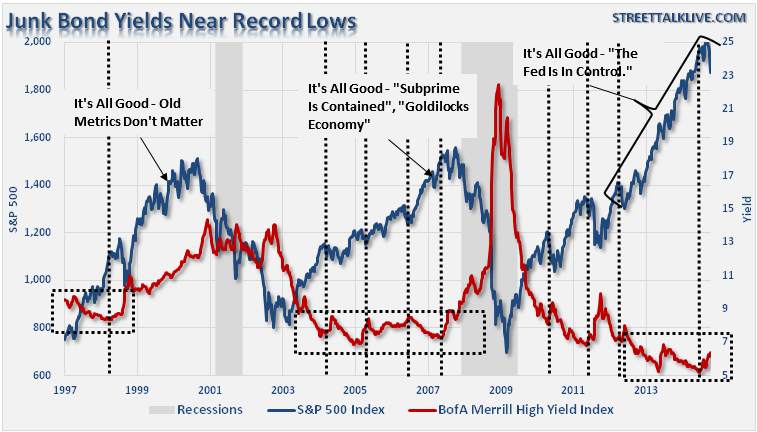Today's Chart Of The Day is a look at the level, and movement, of "junk bond yields" as they relate to the broader stock market. While the media prefers to use the more "marketing friendly" term of "high-yield bonds," the reality is that these are debt securities issued by firms with the substantial levels of credit and default risk.
In more "normal" times, investors would likely be more skittish about taking on excessive levels of potential credit risk in portfolios. But over the last five (5) years the "chase for yield" has surged as central banks globally intervened to effectively eliminate default risk.
As shown, the current yield of "junk bonds" is basing at historically low levels. I have noted that even small upticks in yields have historically been associated with short-term market corrections.

Importantly, it is the "change in trend" from a declining or basing period in yields to a rising one that denotes the ending of a cyclical bull market. This has not yet occurred which is good news for those betting on a continued rise in equity prices. In the 1990's, the immediate impact of a change in the trend of yields was dismissed as it was believed that the markets had entered into a new paradigm. The impact of rising yields came much more quickly in 2007 as the combined onset of the recession and a wide-spread credit crisis sent investors fleeing in panic.
With a staunch belief that the "Fed" currently has all-things under control, investors are once again oblivious to the mounting risks in the financial and credit markets. However, there are several cracks in the foundation of the "junk bond" market that should be recognized.
I have recently written about the rising default risk in high-yield credits. To wit:
"There have been 10 LBO related bond defaults thus far in 2014, compared with nine for all of 2013. The failed LBOs affected $21.8 billion in bonds this year and 26% of all bond defaults since 2008. Caesars would bring the latter tally to 29%. In addition, a Caesars filing would follow two prior restructurings via distressed debt exchanges (DDEs). Since 2008, 24% of issuers engaged in DDEs have subsequently filed for bankruptcy."
And most recently as it relates to the energy sector specifically:
"Junk bond issuance has been soaring as the Fed repressed interest rates and caused yield-hungry investors to close their eyes and take on risks, any risks, just to get a teeny-weeny bit of extra yield. Demand for junk debt soared and pushed down yields further. And even within this rip-roaring market for junk bonds, according to Bloomberg, the proportion issued by oil and gas companies jumped from 9.7% at the end of 2007 to 15% now, an all-time record.”
It is the incredible liquidity flows, combined with promises of suppressed interest rates going forward, that have driven many individual investors to take on much more credit risk than they likely realize. The demand for yield combined with the ability for individuals to use simplified investment products (i.e. ETFs) to make bets has obfuscated the risk being undertaken.
Tracy Alloway and Michael Mackenzie via the Financial Times also made some very important observations in regards to the impact of ETF's on the high-yield credit market and the potential risks therein.
"Fitch’s analysis finds that trading activity in junk, or high-yield, bond ETFs increased sharply during 2013’s 'taper tantrum' as well as three shorter periods of market volatility in January, July and then in September and October of this year.
The research suggests investors may be using ETFs as a convenient way to express changing views on low-rated corporate debt at a time when liquidity, or ease of trading, in the cash market is believed to have deteriorated."
'It appears there’s some migration of trading to high-yield ETFs and that may be a commentary on the underlying liquidity conditions of the high-yield market,' said Robert Grossman, managing director of Fitch’s macro credit research.
The difference between the liquidity promised by ETFs and their underlying assets has prompted concerns over the ability of some of the funds to withstand market stress or potentially distort prices.
ETFs rely on a complex ecosystem of banks and other financial players in order to create the “liquid wrapper” that makes them work.
During last year’s taper tantrum, at least two of the big financial companies that support ETFs curbed redemptions on some of their fixed income ETFs amid heavy one-way selling."
There is a substantial amount of risk built into the "junk bond" market currently. The massive amounts of capital housed in "junk related" credits could be a contributor to another credit related type crisis should defaults began to rise more quickly than expected. Such an event will likely be associated with the onset of a recession and a sharp reversion in asset prices as individuals flee in panic.
It is very likely that "junk bond" yields will once again prove to be a good "early warning indicator" of the next major market reversion and economic recession. That is, of course, if we choose to pay attention. Just how orderly the exodus will be once the redemptions begin is the real question that remains to be answered.
